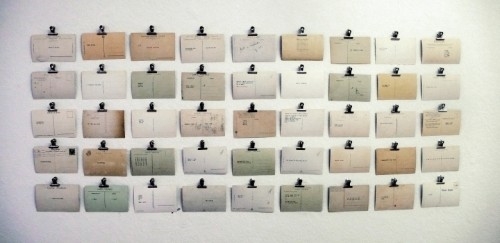Exhibiting Literature
Exhibiting Literature
Ida Bencke
John Holten
Language is normally something we read, say or hear. It is something that unfolds itself in the linear and continuous time it takes to finish a sentence, listen to someone reciting a poem, or read a novel from beginning to end. Here, language holds the promise of disclosing a meaning, which we either understand or do not understand, depending on which tongues or interpretative skills we master. And this kind of utterance is as excluding as it is welcoming for the initiated – the words are as comprehensible for those who already understand, as they are wholly illegible for those on the outside.
Because images speak an iconographic and trans-linguistic vocabulary, the visual arts thrive on an international cultural arena, whereas literature – hopelessly restricted by the limits of language-regions – is struggling to keep up the pace. As a European publishing house working in the space between text and image, this is a problem Broken Dimanche Press is faced with every day. We find ourselves in a happy state of linguistic exile: situated in Berlin, but not mastering German fluently and speaking a variety of more or less broken languages – this is our linguistic reality. We have come to realise that as a publishing house, we epitomise a decidedly contemporary linguistic tendency: the destabilisation of national languages, people constantly thrown out of their native tongues; all of us meeting each other on more or less foreign linguistic grounds.
With our exhibitions series Exhibiting Literature, we would like to explore the various communicative possibilities that exist in the non-semantic, spatial and visual qualities of language. Here we would like to pose the simple question: how does one linguistically articulate, mediate and give rise to an experience, which transcends national and linguistic borders? What happens when language simply installs itself as a physical reality in space?
Ezra Pound, who has delivered many a favourite quote to the world of literature, famously stated: ‘literature is simply language charged with meaning to the outmost possible degree’ and posited that the poem was the locus classicus where the semantic potential of language found its zenith. Normally, we read poems with the belief that the words contain a certain code to be deciphered: with a meaning that lies somewhere beyond the mystifying exterior of the words, a promised land of transcendental significance. From this perspective, the physicality of words – their shape and their sound – function merely as meaning’s servant. But a language that is encountered rather than understood, a language that is seen rather than deciphered is also a language, which installs itself as a thing on the same phenomenological level as that of the body. A poem, for example, which takes on the form of an object, perceivable and accessible to all.
Through this very phenomenological status language takes on an existence of its own – for a while liberated from the artfully speaking cogito. Language in concrete space rather than in abstract time: a sculpture made out of words. There is something, is there not, decidedly inhumane about words in their phenomenological being that their significance escapes our full control? When letters become material – curves and colour – language approaches a potential innocence. And old story, as you know, but a story worth retelling. Attempting, once again, to let language speak for itself.

